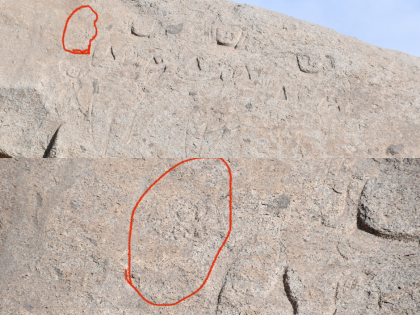Ancient Buddhist Carving Unearthed During Road Widening Work in Leh
By Lokmat English Desk | Published: February 24, 2024 09:12 PM2024-02-24T21:12:03+5:302024-02-24T21:13:58+5:30
A road widening project in Leh, Ladakh, led to the unexpected discovery of an ancient rock carving depicting five ...

Ancient Buddhist Carving Unearthed During Road Widening Work in Leh
A road widening project in Leh, Ladakh, led to the unexpected discovery of an ancient rock carving depicting five figures believed to be Dhyani Buddhas, dating back to the 10th century. Cultural activist and researcher Sonam Wangchok shared a post on X (formerly Twitter).
“Ancient rock carving of Bodhisattvas, seem to be five Dhyani Buddhas belongs to around 10th century discovered during a road widening in Leh. We are fortunate to take timely action to protect it before breaking down," Wangchok wrote in his post, tagging the Ministry of Culture, the Office of the Lt. Governor of Ladakh, and the Archaeological Survey of India (ASI).
Ancient rock carving of Bodhisattvas, seem to be five Dhyani Buddhas belongs to around 10th century discovered during a road widening in Leh. We are fortunate to take timely action to protect it before breaking down. @MinOfCultureGoI@lg_ladakh@DDNational@ASIGoI@IndiaatUNESCOpic.twitter.com/pRQV8nxVc1
— Dr. Sonam Wangchok (@sonam_wangchok) February 24, 2024
About five Dhyani Buddhas
In Buddhist tradition, the Five Dhyani Buddhas hold significant spiritual meaning, representing various aspects of enlightenment and wisdom. As outlined in an article from LearnReligions.com, the Five Dhyani Buddhas are Aksobhya, Ratnasambhava, Amitabha, Amoghasiddhi, and Vairocana. Each Buddha embodies distinct qualities and virtues, such as compassion, fearlessness, and wisdom.
Aksobhya is associated with reflection and transformation, while Ratnasambhava symbolizes generosity and abundance. Amitabha represents boundless light and infinite life, while Amoghasiddhi embodies accomplishment and fearlessness. Vairocana, positioned in the centre, signifies purity and the ultimate truth.
These Buddhas are often depicted in various poses and with specific mudras, each holding symbolic significance. Through meditation and contemplation on these enlightened beings, Buddhists seek to cultivate these qualities within themselves and progress on the path to enlightenment. The Five Dhyani Buddhas serve as guiding figures, offering inspiration and guidance to practitioners worldwide.
About Sonam Wangchok
Sonam Wangchok, known for his contributions to Ladakh's cultural and social landscape, has emerged as a prominent voice advocating for the preservation of indigenous heritage and environmental conservation in the region. With a background rooted in Ladakhi culture and a commitment to community welfare, Wangchok's endeavors have garnered widespread recognition and respect locally and internationally.
Open in app